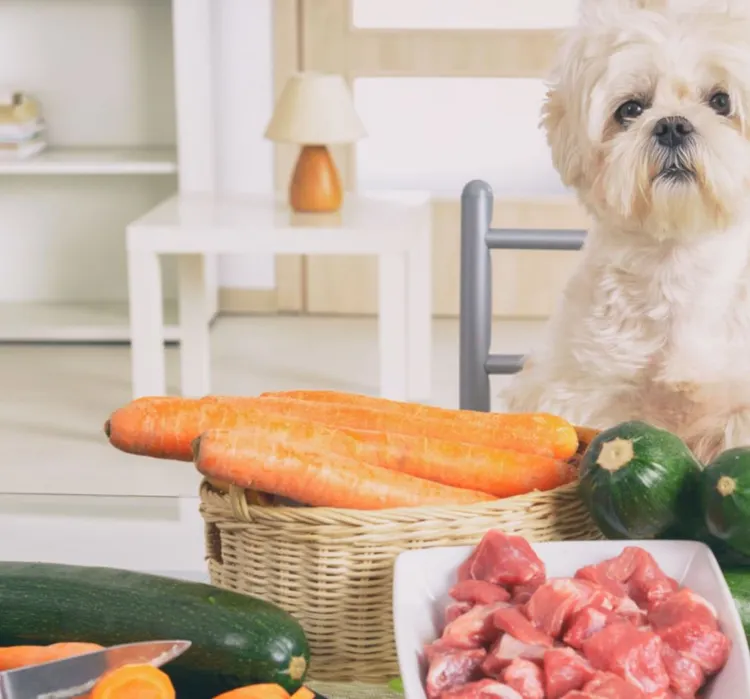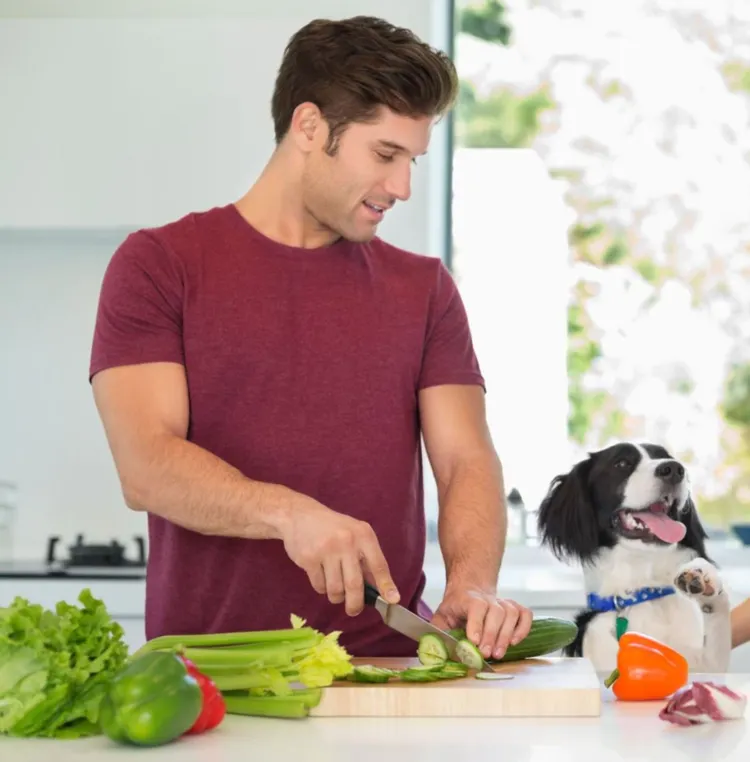You may have heard the saying, “Dogs can eat anything,” but when it comes to cooked food, not all meals are safe for your furry friend. While the idea of preparing homemade meals for your dog may seem appealing, there are significant risks if you’re not careful. From the dangers of cooked bones to toxic ingredients, this guide explores the potential pitfalls of feeding your dog cooked food and offers veterinarian-approved advice on creating safe, balanced meals.
1. The Risks of Feeding Dogs Cooked Bones
One of the most common misconceptions about dog nutrition is that all bones are safe for dogs. While raw bones can offer some benefits, cooked bones are a completely different story and should be avoided.
Bone Splintering
When bones are cooked, they become brittle and can easily splinter. This creates sharp fragments that can cause serious harm to your dog’s mouth, throat, or digestive tract. Swallowed bone shards can puncture the intestines or stomach, leading to internal injuries that may require emergency surgery.
Blockages
Another potential risk with cooked bones is that larger fragments can cause intestinal blockages. Dogs often swallow bone fragments that they cannot fully digest, leading to severe constipation, vomiting, and lethargy. In some cases, blockages can be life-threatening, requiring immediate veterinary attention.
Safer Alternatives
For pet owners looking for ways to satisfy their dog’s natural chewing instinct, consider offering raw bones (with your vet’s approval) or high-quality chew toys. Raw bones are typically softer and less likely to splinter, but they still need to be given under supervision. Alternatively, look for rubber or nylon chew toys that can help keep your dog’s teeth clean without the risks associated with cooked bones.
2. Common Cooked Foods to Avoid
While some cooked foods are perfectly safe for dogs, others can be toxic or harmful. Knowing which ingredients to avoid is essential for any pet owner considering home-cooked meals.
Toxic Ingredients
Several everyday ingredients that are commonly found in human food are toxic to dogs:
- Onions and Garlic: Both can cause damage to a dog’s red blood cells, leading to anemia.
- Chocolate: Contains theobromine, which is highly toxic to dogs and can result in heart problems, seizures, or even death.
- Grapes and Raisins: Can cause kidney failure, even in small quantities.
- Xylitol: A sugar substitute found in many sugar-free products, xylitol can cause a life-threatening drop in blood sugar levels.
High-Fat Foods
Fried foods, fatty cuts of meat, and other high-fat dishes can lead to pancreatitis in dogs. This condition causes the pancreas to become inflamed, leading to vomiting, diarrhea, and abdominal pain. Severe cases of pancreatitis require hospitalization, making it essential to avoid high-fat, fried foods.
Salt and Seasonings
Excessive salt and seasonings can also be dangerous for dogs. Salt toxicity can lead to symptoms like dehydration, vomiting, and seizures. Spices such as nutmeg, black pepper, and certain herbs like chives can also cause gastrointestinal upset.
3. Safe Home-Cooked Meals for Dogs
If you’re interested in preparing home-cooked meals for your dog, it’s possible to do so safely with careful planning. By using appropriate ingredients and following guidelines from veterinarians, you can ensure that your dog gets the nutrition they need without the risks associated with harmful foods.

Vet-Approved Recipes
Some simple, vet-approved recipes can form the basis of a balanced diet for your dog. For example, meals consisting of boiled chicken, sweet potatoes, and brown rice provide a solid combination of proteins, carbohydrates, and vitamins. These meals are easy to prepare and gentle on your dog’s stomach.
Balanced Nutrition
Dogs, like humans, require a balance of proteins, carbohydrates, and fats to stay healthy. However, they also need certain vitamins and minerals to thrive. Calcium is one crucial nutrient that should not be overlooked in a homemade diet, as dogs require it for strong bones and teeth. Other important nutrients include omega-3 fatty acids for skin and coat health and fiber for digestion.
Supplements
In many cases, homemade meals will need to be supplemented with additional vitamins and minerals to meet your dog’s nutritional needs. Common supplements include fish oil for omega-3s, bone meal for calcium, and digestive enzymes to aid in nutrient absorption. Always consult a veterinarian before adding any supplements to your dog’s diet to ensure they are receiving the correct dosages.
4. Should You Transition to Home-Cooked Dog Food?
Switching to home-cooked meals can be beneficial, but it should be done with caution and guidance from a veterinarian. Homemade diets can sometimes lack essential nutrients, so it’s important to ensure that your dog’s meals are well-balanced.
Consult a Veterinarian
Before transitioning your dog to home-cooked food, it’s essential to speak with a veterinarian. Your vet can help you understand your dog’s specific nutritional needs and provide guidance on creating balanced meals. They may also recommend a board-certified veterinary nutritionist to help you develop a long-term feeding plan that meets your dog’s unique requirements.
Gradual Transition
To avoid digestive upset, it’s important to transition your dog to home-cooked meals gradually. Start by mixing small amounts of the new food with your dog’s current food and increase the proportion of homemade food over several days. This gradual approach helps your dog’s digestive system adjust to the change without causing diarrhea or vomiting.
Monitor Weight and Energy Levels
Once your dog is fully transitioned to home-cooked meals, keep a close eye on their weight, energy levels, and overall health. Dogs that gain or lose weight unexpectedly or seem lethargic may not be receiving the proper nutrients from their meals. Regular vet check-ups and blood tests can help ensure that your dog’s diet remains balanced and meets their nutritional needs.
5. Eco-Friendly Tips for Cooking Dog Food
As an eco-conscious pet owner, you can take steps to ensure that your homemade dog food aligns with your sustainability goals. By choosing organic ingredients, reducing food waste, and using eco-friendly storage options, you can create healthy meals that benefit both your dog and the environment.
Use Organic Ingredients
When cooking for your dog, prioritize organic ingredients. Organic meats and vegetables are typically free from harmful pesticides and antibiotics, making them a healthier option for your dog. Additionally, organic farming practices are often more sustainable, reducing the impact on the environment.
Minimize Waste
You can also minimize food waste by repurposing leftover vegetables or meat scraps—provided they are safe for dogs to eat. For example, leftover carrot tops or sweet potato peels can be boiled and mixed into your dog’s meals, reducing the amount of food that ends up in the trash.
Eco-Friendly Storage
Instead of using plastic bags or containers, opt for reusable glass jars or stainless steel containers to store your dog’s food. These eco-friendly storage solutions help reduce plastic waste while keeping your dog’s food fresh for longer.

Cooking for your dog can be a rewarding way to ensure they get nutritious, safe meals, but it’s essential to avoid common risks like cooked bones and toxic ingredients. With some planning, expert guidance, and eco-conscious practices, you can provide home-cooked food that benefits both your pet and the environment. Always consult with a veterinarian before making major changes to your dog’s diet and monitor their health regularly to ensure they are thriving on their new meal plan.



